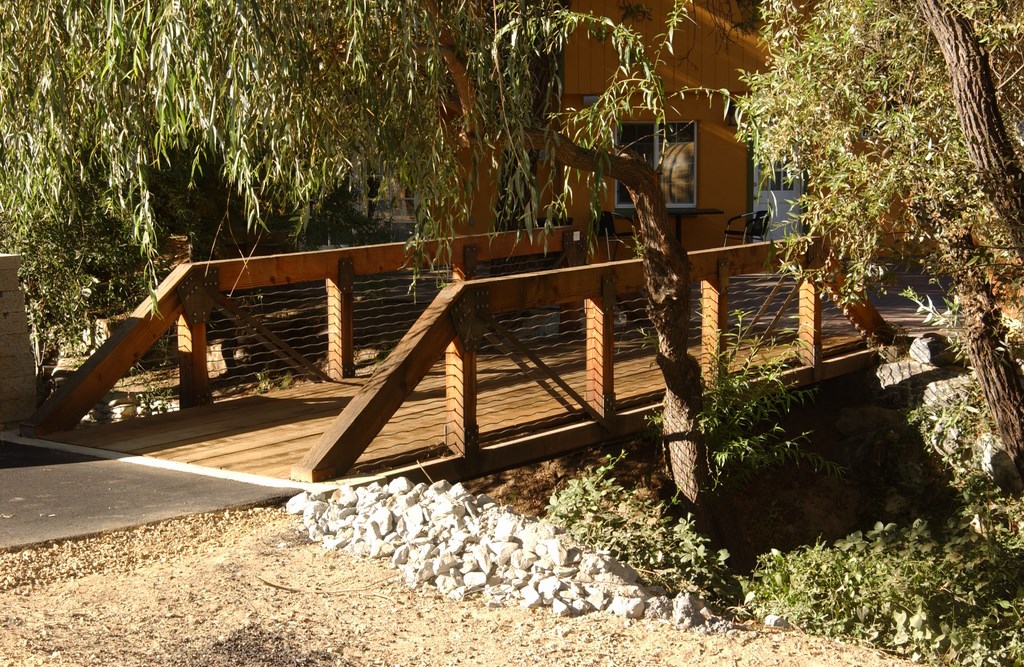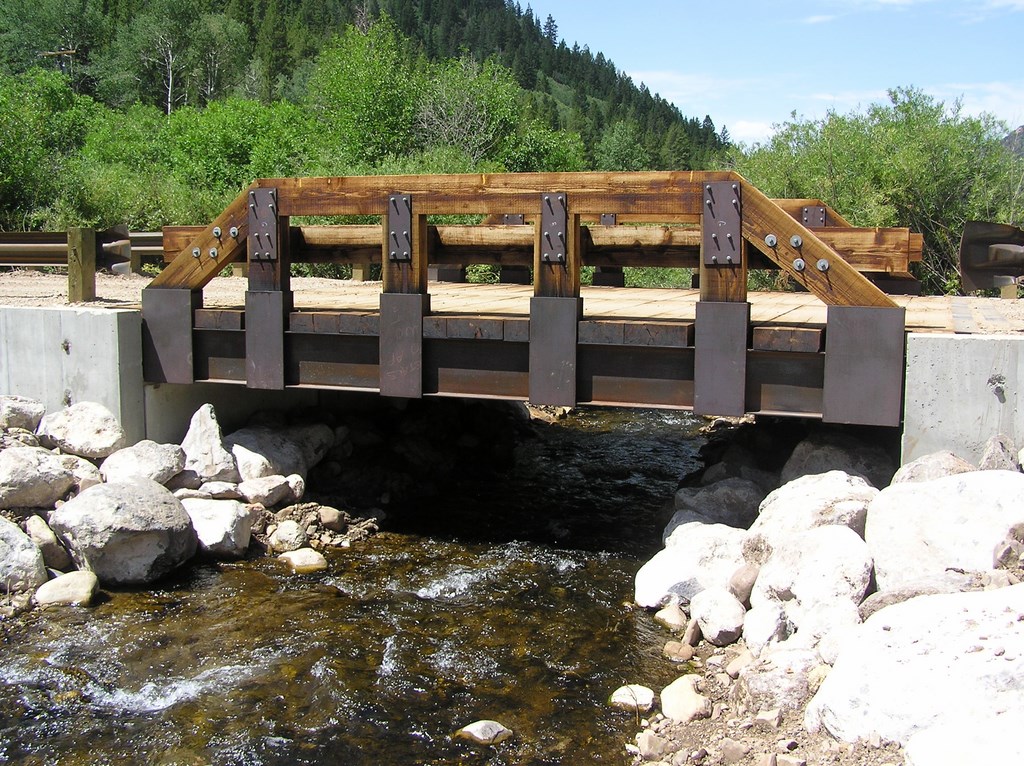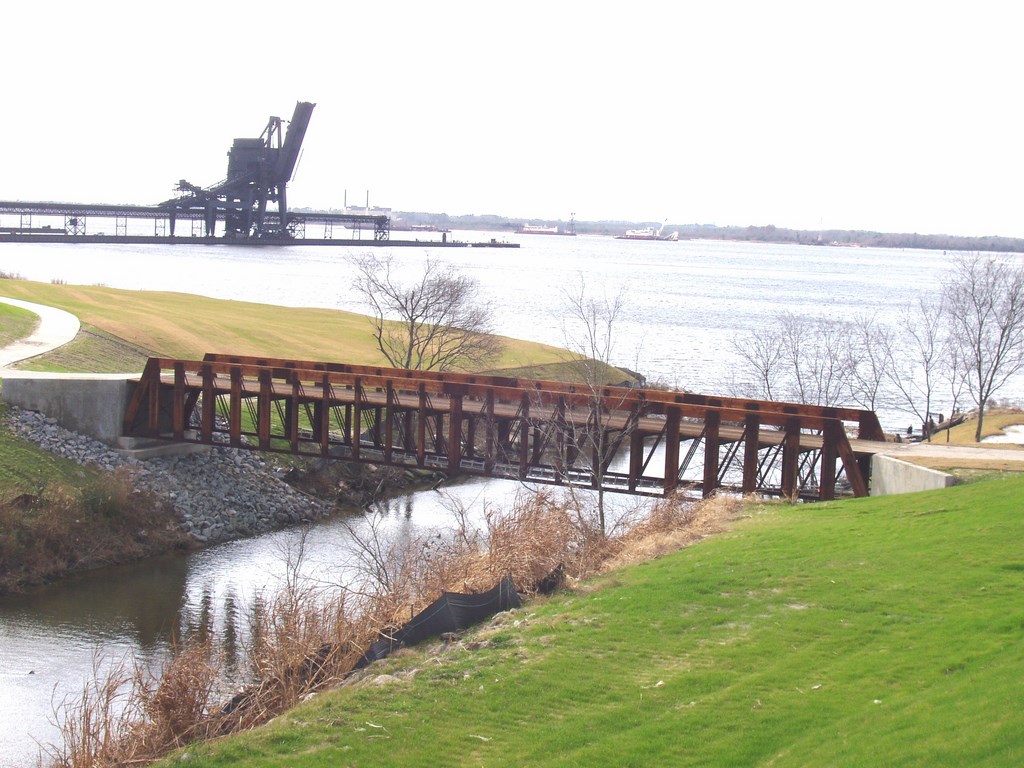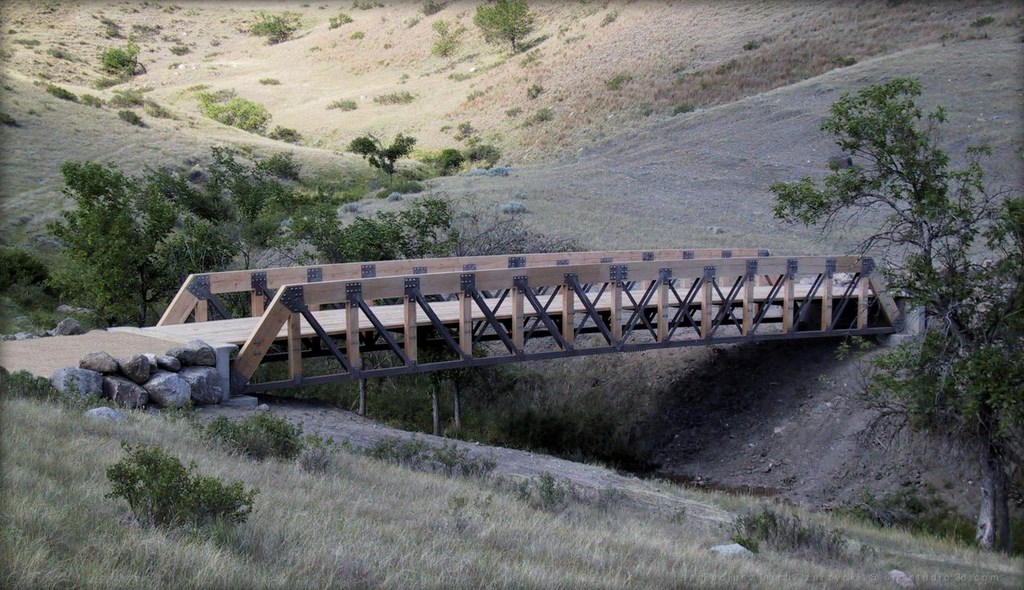Spanning Space and Time

Bridges have been important to humanity for thousands of years. They’ve provided avenues of travel between disconnected spaces and have, as a result, been critical to commerce, settlement, warfare, travel and even poetry and literature. To this day, they are iconic in certain cities or regions (think Paris or New York), and there has always been a distinctly romantic air that accompanies their obvious utility.
My relationship with bridges in general (and with wooden bridges in particular) began during my childhood near Nebraska’s Niobrara River. The big, load-bearing structures crafted to span that river in the late-19th and early-20th centuries absolutely fascinated me.
I’d spend hours climbing on those old structures and was amazed by the way they creaked as their tension and compression members supported truly formidable weights. At the same time, I came to value the presence of water in the landscape and the way bridges interacted with the streams, lakes and rivers rippling beneath them.
Not entirely adrift from those childhood interests, I’ve spent most of my adult life as a woodworker, mostly in the construction of custom homes. My life and career took a major turn, however, when I was given the chance to combine my professional skills with my early passion – an opportunity that led me to form Moosman Bridge eight years ago as a firm entirely dedicated to the design and construction of wooden bridges.
CONNECTIONS
From the start, my business has been about creating structures that are as beautiful as they are functional. I’ve long been captivated by the architecture of Frank Lloyd Wright and the designers of the Arts & Crafts Movement and like to think that our bridges reflect their design sensibilities.
As it turns out, we’ve found clients who have been interested in exactly that approach and have shared our view that our wooden structures fit extremely well into verdant landscapes as functional and aesthetic elements.
| Some of the bridges we build are visually quite simple, as these examples from our Tioga line demonstrate. These bridges are completely utilitarian with little adornment – but lots of durability and longevity. |
Our wooden bridges are similar to steel bridges in many respects, except that we rely on wooden members that are bolted together instead of steel ones that are welded or riveted. In a properly engineered design, the combination of wood and bolts creates a relatively lightweight structure that supports many times its own weight.
As mentioned above, I had worked with wood for many years, building custom homes before getting involved with building bridges. As is true of other woodworkers, I derive tremendous satisfaction working with wood and from applying and expanding upon the great traditions of craftsmanship developed through the centuries. I love the way wood looks, smells and feels and admire its flexibility, durability and strength. I also like the fact that we are continuing to apply methods of construction that first emerged in the late-19th Century.
| The angular bridges from our Niobrara line are a step up from the simplicity of the Tioga line, both structurally and visually. As they weather and age, they blend beautifully into their landscapes – strong statements clearly suited to their settings. |
As part of my former general-construction business, I’d built many reinforced-concrete bridges on rural roadways in the Midwest. In many situations, ironically, I’d remove existing wooden bridges, but rather than discard the material (much of which was still structurally viable), I stored it and through the years accumulated a stock of valuable and irreplaceable raw material.
At first, however, I wasn’t thinking about bridges. In fact, my first project with the recycled wood was a 7,500-square-foot custom home in Valentine, Neb. (This stock is long gone, and all our bridges are now fabricated from new Douglas Fir.)
Not long after building that big home, I was playing golf at a local course and noticed that one of its bridges was in need of replacement. I offered my services at an extremely reasonable rate and ended up putting in a couple of bridges. Before long, a golf course designer/friend saw them and casually mentioned that he thought there was a tremendous niche that could be filled by someone making wooden bridges that would look at home in landscapes.
CAREFUL CONSTRUCTIONS
To my knowledge, ours is the only bridge-building company that uses natural Douglas Fir timbers to construct bridges on this scale. Others use composite materials and/or wood laminates, but we’ve made good mileage with those who believe in using the real thing. We also believe in the aesthetic value of these structures and make no bones about the fact that our bridges are not simply a means of crossing a body of water, but are also features that can greatly enhance their surroundings.
| All of our bridges are fully assembled at our facility before shipment to ensure that everything fits properly, including this large example from our Cherry County line (left). In some cases, we combine types of bridges (middle) to create larger or specialized spans (as with this combination of Cherry County- and Grizzly-style bridges). We also manufacture custom bridges, such as this stout model for a road in Summit County, Utah (right). |
The accompanying photographs depict the four basic bridge styles with which we work. Each is engineered and built to match the specific spans and widths required by the individual project.
We manufacture each bridge in our shop and completely assemble every one of them before shipping to ensure that all components fit together perfectly. We then ship them to the site for installation by the clients’ crews. (We provide technical support for the assembly process and in many cases consult on the construction of any necessary abutments or footings.)
It’s extremely important that the wood be dry before processing so that once the components are matched and assembled there will be limited shrinkage.
|
It’s in the Trees All of our bridges are made entirely of coastal Douglas fir pinned together with structural steel bolts. This choice of wood species is a no-brainer: [ ] First, it’s widely available from a number of sources in the Pacific Northwest and in sizes suited to large-scale construction. [ ] Second, structural engineers have long hailed Douglas fir as a premium material for the building of large structures, reserving their highest praise for material harvested near the coast instead of material grown inland. There’s just something about the coastal material’s consistency of grain and incredible load-bearing capacity. [ ] Third, coastal Douglas fir is also remarkably durable: I’ve worked on large wooden towers for fire lookouts that have been in place for decades and the structural integrity is still on the mark, even with maximum exposure to the elements.In the case of our bridges, this wood supports a minimum of 85 pounds per square foot across structures that might in total weigh no more than 70,000 pounds. The wood can also get wet and dry out and not suffer any structural degradation, and as it weathers, it only becomes more and more visually appealing. The wood structures we build are excellent for handling structural compression, while steel is ideal for supporting tensional loads. Although concrete bridges are basically pre-stressed cables encased in concrete and wooden bridges distribute stresses across a truss, the structural principles involved are actually quite similar. — D.M. |
Once milled, we treat all of the wood with shingle oil for protection from dirt and moisture during shipping. This oil eventually dissipates, leaving unfinished wood that naturally ages in the wind, sun and rain to gain a beautiful, silvery patina that adds to the structure’s natural and aged appearance. (For bridges that will be installed in extremely wet or cold climates, however, we treat the wood with a chemical sealer to augment its longevity.)
Because wood is a natural material and conditions vary tremendously from place to place, how wooden bridges will fare once installed is unpredictable. We can’t make guarantees, but under optimal conditions in which a bridge is properly installed and not subjected to physical abuse, it’s reasonable to assume a service life well in excess of 50 years.
Eight craftsmen fabricate our bridges in the shop, and once they’re finished we all make a point of walking across them, satisfied to know that we are just the first among tens of thousands of people who will cross them through the years.
INTO THE LANDSCAPE
Our bridges aren’t “custom” productions in that we stick to four basic forms, but the appearance of each of them can vary tremendously from the others based on the dimensions of the individual bridge and the way each fits into its setting.
As is true of many Craftsman-style structures, the aesthetic appeal comes through the way in which functional members – in this case the trusses, beams and rails – serve as parts of the composition. The distinct forms created by these members are visible from great distances and stand out against the landscape in a way that suggests great age and colorful histories.
| Bridges in the Grizzly line clearly demonstrate that even though we offer only four standard bridge models, no two from any line are exactly alike out in the field – partly because they vary in length, but mainly because they absorb much of their visual energy from the different settings in which they’re placed. And it only gets better as they age, with the steel taking on a rusty glow and the wood progressing to a warm, silvery hue. |
When we started, of course, I wasn’t really sure where our bridges would ultimately wind up, but it was always my thought that if we produced a quality product that was also beautiful to behold, the market would basically take care of how they would be used. Nearly a decade into the process, I believe that the prime settings into which our bridges are finding their ways is proof that I was correct.
Our clients seek design elements and structures that are beautiful and will enhance a beautiful landscape, not disrupt it. That has opened us to work not only for golf courses, but also for state and national parks, retirement communities, residential developments, resort properties and even rural highways – any setting in which a special, rustic touch has value.
Dan Moosman is president and founder of Moosman Bridge, a manufacturer of wooden bridges based in Valentine, Neb. A lifetime woodworker, homebuilder and craftsman, Moosman has constructed wooden and timber-frame custom homes as well as highway bridges and a range of wooden structures throughout the Western and Midwestern United States. He started his current business eight years ago after recognizing a niche in the landscape industries for small wood-and-steel bridges. He also continues to build custom wooden homes in his spare time.























